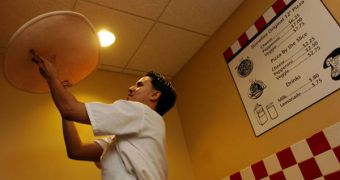In their quest to create the next generation of micro motors, smaller in size than the width of a human hair, experts at the Monash University have turned to studying the physics of pizza tosses as a source of inspiration. And it would appear that the two are not all that different, experts at the university say, because they have managed a breakthrough following their observations, when they analyzed short films of “professional” pizza tossers.
The scientists looked at the height of the toss, its spin, the speed of the dough through the air, its rotation velocity, as well as at its stability and energy efficiency. After this step, Associate Professor James Friend and Senior Lecturer Leslie Yeo, both of whom supervise PhD student Daniel (Kuang-Chen) Liu, have created a set of nonlinear differential equations that, as weird as it sounds, capture the essence of the pizza-throwing art.
“In brief, if you toss a pizza dough one toss at a time – that is, if you toss then catch – your hands should move in a helical fashion, like they are moving along a spiral, a curved line laid along a cylinder. If you are tossing the pizza continuously, not stopping to catch it and stop every time, then your hands should move in circles,” Professor Friend said. The expert added that these equations could significantly further the development of next-generation standing wave ultrasonic motors (SWUM), which, oddly enough, operate on the same basic principles as a pizza toss.
Friend explained that, “The SWUM works exactly like a pizza chef tossing dough, with the hands representing the vibrating stator of the SWUM and the dough representing the rotor. The difference is only in the details: a chef tosses dough, about once a second, a few tens of centimeters into the air. A SWUM tosses the rotor a few million times a second into the air.” The devices are to be used for a new type of minimally invasive neuro-microsurgery, in which there is no mechanical part driving the drill head. Rather, the stator, which is immobile, generates an ultra-sonic lift, pushing the movable part, the rotor, up and down, while at the same time imprinting it with a circular motion.
“Some of the maths are a bit tricky. The most puzzling questions with SWUMs are answered in this study. We think that further investigation of the work will prove fruitful for the understanding and design of SWUMs,” Friend shared. He also stated that the innovation had the potential to power up the miniature surgical instruments of the future, as well as to push artificial particles carrying drugs through the bloodstream, in places where conventional shots could not deliver them.

 14 DAY TRIAL //
14 DAY TRIAL //